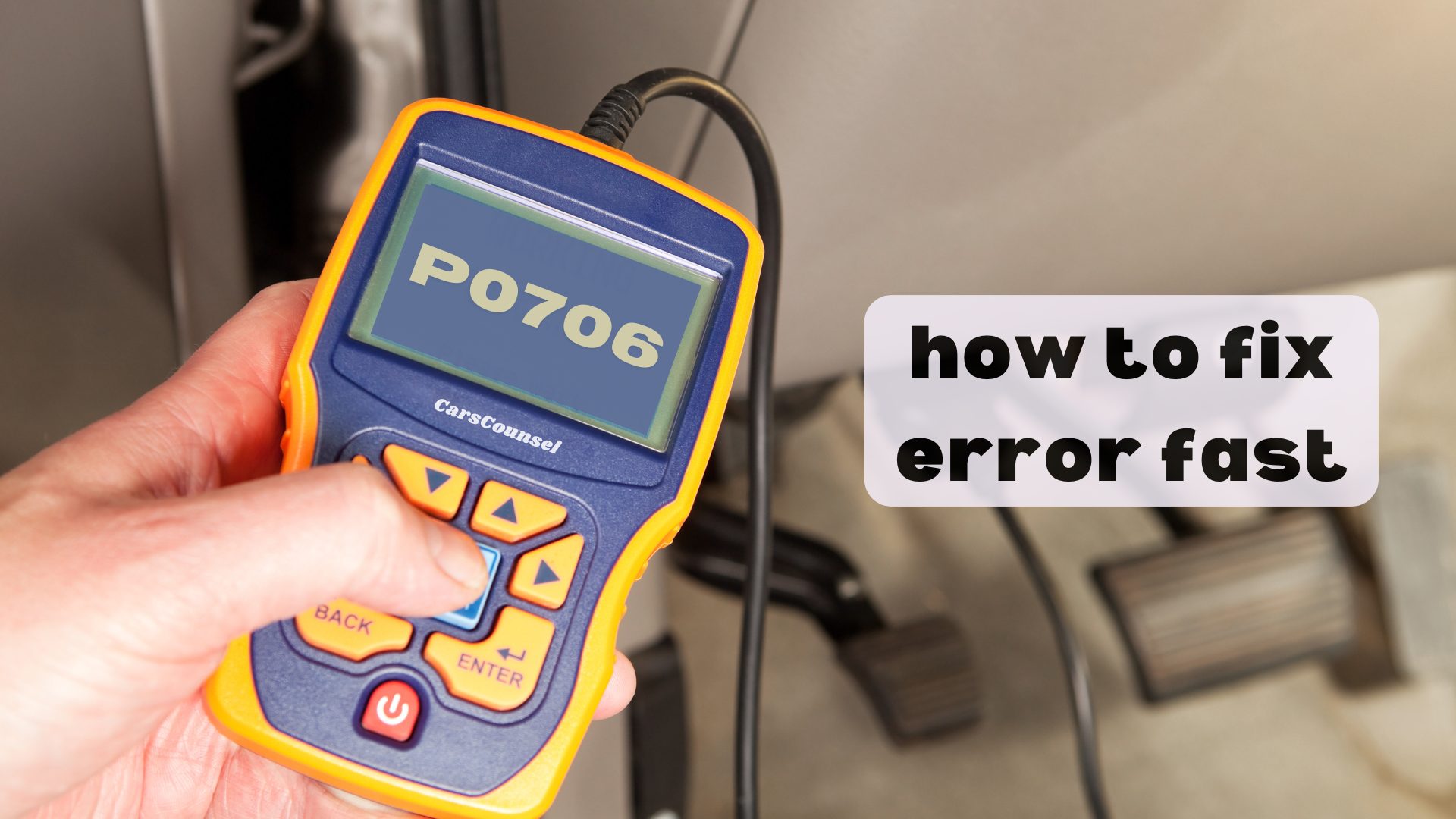When you see a P0706 code, it’s crucial to act fast to prevent bigger issues. This error relates to the transmission range sensor and can lead to more serious problems if left unchecked.
First, confirm its is the part of OBD2 Codes with an OBD-II scanner and check the sensor and its wiring for any damage or rust.
But that’s just the start. What else should you do to ensure a full repair and avoid future issues? Let’s go over the key steps to get your car running smoothly again.

Quick Navigation
Key Takeaways
- Use a code reader to check if the P0706 code is present.
- Look for any damaged or rusty wires and fix them.
- If needed, replace the broken transmission range sensor.
- Make sure the transmission fluid is at the right level for the sensor to work properly.
What Is the P0706 Code?
The P0706 code means there’s a problem with the transmission range sensor circuit. This sensor helps the car’s computer (ECM) know which gear you’re in.
If it malfunctions, the car might shift gears roughly, slip out of gear, or go into a ‘limp’ mode to protect itself. The sensor uses advanced technology to tell the computer what gear you’re in, but if it fails, the computer gets confused.
This code means the computer can’t trust the signals from the sensor, which messes up how the car drives. To keep your transmission working well, it’s important to make sure this sensor is in good shape.
Causes of the P0706 Code
A P0706 code usually happens when there’s an issue with the transmission range sensor, wiring problems, a broken transmission control module, or corroded sensor circuits. Things like moisture and dirt can also cause issues. Taking care of your transmission and checking the sensors regularly can help you spot these problems early.
| Cause | Impact on Vehicle |
|---|---|
| Faulty Transmission Range Sensor | Erratic shifting, limp mode |
| Wiring Problems | Disrupted sensor functionality |
| Failed Transmission Control Module | Inaccurate gear determination |
| Corroded Sensor Circuits | Sensor malfunction |
Knowing these causes lets you take steps to keep your transmission in good shape. Fixing wiring issues, keeping sensor circuits clean, and protecting the sensors from moisture and dirt can help you avoid a P0706 code.
Affected Car Models
Understanding why the P0706 code happens is important, but knowing which car models often have this issue can help you fix it faster. While many cars can have this problem, some are more prone to it.
Here are four car models that frequently have the P0706 code:
- Honda Element: Often has problems with the transmission range sensor.
- Honda Accord: Models from 2003 to 2017 commonly report this error.
- Nissan 350Z: Frequently deals with issues related to the transmission range sensor circuit.
- Nissan Murano: This error is often reported in these models.
Knowing these specific models can make your diagnostic process quicker and lead to more effective repairs.
Symptoms of the P0706 Code
Symptoms of the P0706 Code
When your car has a P0706 code, you might see the Check Engine Light come on and have trouble with shifting gears. You could also hear strange noises from the transmission and notice that the car doesn’t accelerate as well as it should. Many people think these problems mean the transmission is failing, but that’s not always true. Good troubleshooting can find the real issue.
| Symptom | Description |
|---|---|
| Check Engine Light | Turns on when the P0706 code is set. |
| Shifting Problems | Hard or slow gear changes. |
| Unusual Transmission Noises | Clunking or whining sounds from the transmission. |
| Reduced Acceleration | Car struggles to speed up smoothly. |
Knowing these symptoms can help you catch the problem early and fix it effectively.
Diagnosing the P0706 Code
To diagnose the P0706 code accurately, follow these steps:
- Scan for Codes: Use an OBD-II scanner to confirm the P0706 code is present.
- Check Wiring and Connections: Look at all the wires and connectors related to the transmission sensors for any damage or corrosion.
- Test Transmission Sensors: Use the right tools to make sure the transmission range sensor is working properly.
- Inspect the Transmission Control Module (TCM): If the sensor is fine, check the TCM for any faults.
- Look for Other Codes: Scan for other trouble codes that might give more clues about the issue.
Checking Transmission Fluid
Checking the transmission fluid is a key step in figuring out the P0706 code, as the wrong fluid levels or dirty fluid can mess with sensor performance and the transmission itself.
First, find your vehicle’s transmission dipstick. Make sure the car is on a flat surface and the engine is warm.
Pull the dipstick out, wipe it clean, put it back in, and then pull it out again to check the fluid level. The fluid should be within the recommended range and look clear and reddish.
If the fluid looks dark or smells burnt, it’s a sign that the fluid is bad and needs to be changed.
Regularly checking and replacing transmission fluid is crucial to avoiding transmission problems and keeping your car running smoothly.
Scanning for Other Codes
Scanning for Other Codes
When you’re checking for the P0706 code, it’s important to look for other trouble codes that might be linked to the transmission issue. Using advanced diagnostic tools can make this process easier.
Here are the main steps:
- Plug in the OBD-II Scanner: Connect your diagnostic tool to the car’s OBD-II port to get any stored codes.
- Look for Multiple Codes: Check if there are other codes that could point to problems with wiring, the Transmission Control Module (TCM), or other parts.
- Understand Code Relationships: Figure out if the extra codes are signs of a bigger issue or just separate problems.
- Record Your Findings: Write down all the trouble codes and what they mean for future reference.
These steps ensure a thorough diagnosis.
Repair Options for P0706
Fixing the P0706 code usually means replacing the bad transmission range sensor, which is often the main problem.
Start by swapping out the sensor to make sure the transmission and engine control module (ECM) can talk to each other correctly again.
Also, check the wiring thoroughly, because broken or loose wires can mess up the sensor’s work. Look for any signs of wear, rust, or damage in the wiring and connectors.
If you find any issues, fix or replace the wiring to ensure a solid connection.
After you finish the repairs, use an OBD-II scanner to clear the code and make sure the problem is fixed and not affecting your car’s performance anymore.
Costs of Repairing P0706
After dealing with the repairs for a P0706 code, it’s good to know what the costs might be. The price can vary a lot depending on what the problem is and what kind of car you have. Here’s a general idea of what you might spend:
- Replacing the Transmission Range Sensor: This usually costs between $110 and $140 for parts and labor.
- Fixing Wiring and Connectors: This can cost anywhere from $50 to $200, based on how bad the damage is.
- Flushing and Refilling Transmission Fluid: Expect this to cost about $150 to $300.
- Diagnostic Fees: A thorough check-up will likely cost between $75 and $150.
Knowing these costs can help you plan and choose the best way to fix your car.
Preventive Measures
To keep your car’s transmission in top shape, you need to do regular maintenance and take some proactive steps.
First, follow the recommended transmission maintenance schedule for your vehicle. Regularly check and change the transmission fluid to keep it clean and ensure everything runs smoothly.
Pay attention to how you drive, too. Avoid aggressive driving and heavy towing, as these can stress the transmission.
Also, check and fix any wiring issues right away to keep the sensors working properly.
Lastly, watch out for any unusual transmission behavior and address it early to prevent major problems.
More OBD-II Codes
Frequently Asked Questions
How Long Can I Drive With a P0706 Code?
You shouldn’t drive for long with a P0706 code. How long you can drive depends on the symptoms, but driving with this issue can be risky for your transmission. Get it checked and fixed right away to avoid more damage or unsafe driving conditions. Make fixing it a priority.
Can a P0706 Code Cause Permanent Damage to My Transmission?
Can a P0706 code cause permanent damage to your transmission? It could. Ignoring a sensor issue can seriously harm your transmission, causing rough shifting, slipping gears, and eventually, costly repairs. Take care of it right away.
Are Aftermarket Transmission Range Sensors Reliable for Fixing the P0706 Code?
Aftermarket sensors can fix the P0706 code, but there are concerns about how reliable they are. Make sure the sensor is good quality and works with your car to avoid more problems. It’s a good idea to ask a professional mechanic for advice.
Will a P0706 Code Affect My Vehicle’s Fuel Efficiency?
You’ll see a connection between your vehicle’s fuel efficiency and how well the transmission works. A P0706 code can affect fuel efficiency because it causes rough shifting and slipping gears. This makes the engine run less efficiently and use more fuel.
Can I Fix a P0706 Code Myself, or Do I Need a Mechanic?
You can try to fix a P0706 code yourself by checking the wiring and replacing the sensor. But if you’re not sure what to do or don’t have the right tools, it’s a good idea to see a mechanic for a proper check and repair.
Conclusion
In short, fixing the P0706 code quickly is crucial for keeping your vehicle running well.
Ignoring transmission issues can end up costing you more than $3,000 in repairs.
By using an OBD-II scanner to check for problems, looking at the transmission range sensor, and making sure the fluid levels are right, you can avoid those big expenses.
Fixing the P0706 code right away not only saves money but also ensures a smoother, safer drive.
Don’t wait—take action now!

